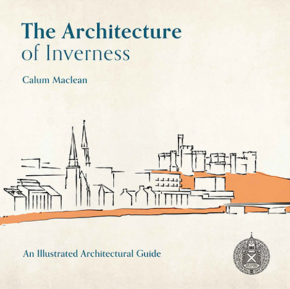The Architecture of Inverness: an illustrated architectural guide
The Architecture of Inverness: an illustrated architectural guide, Calum Maclean, Aiteas Architectural Press, 2020, 336 pages, 30 black and white and 362 colour illustrations, hardback.
Inverness is in a relatively remote part of the country more famous for wild empty landscapes of scattered communities. In spite of its rather unassuming title, this book is much more than a review of buildings within and in the vicinity of Scotland’s most northerly city. In celebrating the architecture of Inverness, the book examines not only the design and historical context of each building, but it also develops a historical narrative that links each building from prehistoric times to the present day.
The author reveals the evolution of ideas, explaining how one building informed the development of another, or where events forced a sudden change in direction, sometimes with unexpected consequences. Through each period of its history there are buildings that illustrate an awareness of current political and philosophical thinking from across Europe, and an aspiration or perhaps determination on the part of the community to be at the forefront of progress.
The reader will be surprised and delighted to discover renaissance mansions, Parisian boulevards, and white cubist villas from the 1930s inspired by the Bauhaus and Russian constructivist turbine halls. There are flashes of brilliance, such as the Queensgate development by Alexander Ross and the arts-and-crafts elegance of Rossal by WL Carruthers. Other buildings, such as Balnain House or the Forbes Mausoleum, are mere fragments of a once vast merchant empire. Buildings that might otherwise have remained hidden and forgotten have had a new light thrown on them.
Most of the buildings featured in the book are modest in scale. It would be unfair to draw comparison with the majestic palaces of London or the enlightenment splendour of Edinburgh, and to do so would rather miss the point. The author takes us on a detective adventure, revealing the clues to a story that would otherwise remain hidden from view. His approach transforms a collection of fine architectural buildings into an unexpected and compelling story about the evolution of people, place and identity.
By examining groups of buildings, and interpreting their significance to the community in which they are found and their collective contribution to the evolution of place and identity, the author perhaps suggests a new approach to our understanding and appreciation of the built environment. It reveals a weakness in our current approach, where buildings are assessed for protection on an individual basis, and where their qualities are measured against criteria intended to provide a quality benchmark but fail to recognise their importance and value to the local context.
The book is illustrated with large colour photographs of exceptional quality. The text is well laid out and as a consequence the format is attractive for reading at home. But the book might be a bit cumbersome for carrying around the streets, so it is accompanied by an app that can be downloaded to a smartphone. Using the phone’s GPS, the app can identify your location and tell you about buildings nearby; or the user can select a particular building from the index, which is grouped by historical period or location, and the app will provide GPS navigation to that building.
This article originally appeared as ‘Narration and navigation’ in Context 165, published by The Institute of Historic Building Conservation in August 2020. It was written by John T Duncan, former conservation architect at Highland Council, director and trustee of Inverness City Heritage Trust and Highland Historic Buildings Trust.
--Institute of Historic Building Conservation
Related articles on Designing Buildings Wiki
- A review of Scotland's historic lighthouses.
- Caithness Broch Project.
- Conservation in the Highlands and Islands.
- Conservation.
- Conversion of Blairtum House, Scotland.
- Development of sustainable rural housing in the Scottish Highlands and Islands.
- Engaging communities in our Highlands and Islands.
- Heritage.
- IHBC articles.
- Institute of Historic Building Conservation.
- Lord Leverhulme on Lewis and Harris.
- New architecture of Scotland’s west coast.
- Orkney gables.
- Re-thatching a Hebridean blackhouse.
- Scotland’s new guide on managing climate-change risk to historic sites.
- Skara Brae and Scotland's dynamic coast.
- The challenges and opportunities of conservation in the Highlands and Islands.
- United Free Church of Scotland: Design for Manses in the Highland Districts.
IHBC NewsBlog
Old Sarum fire in listed (& disputed) WW1 Hangar - Wiltshire Council has sought legal advice after fire engulfed a listed First World War hangar that was embroiled in a lengthy planning dispute.
UK Antarctic Heritage Trust launches ‘Virtual Visit’ website area
The Trust calls on people to 'Immerse yourself in our heritage – Making Antarctica Accessible'
Southend Council pledge to force Kursaal owners to maintain building
The Council has pledged to use ‘every tool in the toolbox’ if urgent repairs are not carried out.
HE’s Research Magazine publishes a major study of the heritage of England’s suburbs
The article traces the long evolution of an internal programme to research 200 years of suburban growth
IHBC Context 183 Wellbeing and Heritage published
The issue explores issues at the intersection of heritage and wellbeing.
SAVE celebrates 50 years of campaigning 1975-2025
SAVE Britain’s Heritage has announced events across the country to celebrate bringing new life to remarkable buildings.
IHBC Annual School 2025 - Shrewsbury 12-14 June
Themed Heritage in Context – Value: Plan: Change, join in-person or online.
200th Anniversary Celebration of the Modern Railway Planned
The Stockton & Darlington Railway opened on September 27, 1825.
Competence Framework Launched for Sustainability in the Built Environment
The Construction Industry Council (CIC) and the Edge have jointly published the framework.
Historic England Launches Wellbeing Strategy for Heritage
Whether through visiting, volunteering, learning or creative practice, engaging with heritage can strengthen confidence, resilience, hope and social connections.















